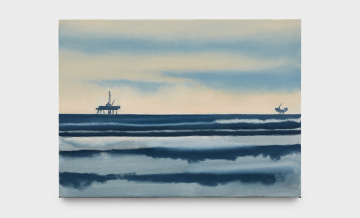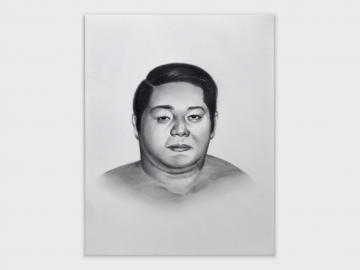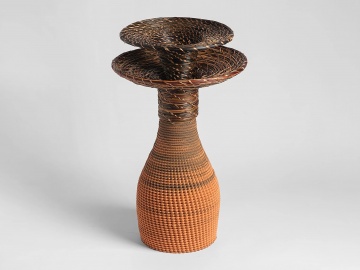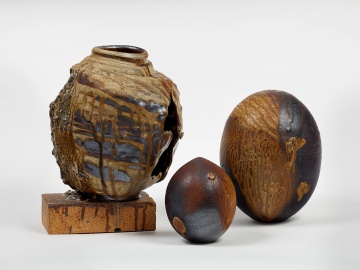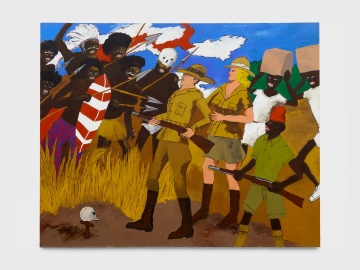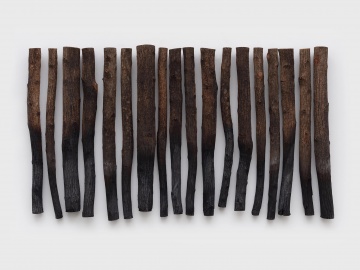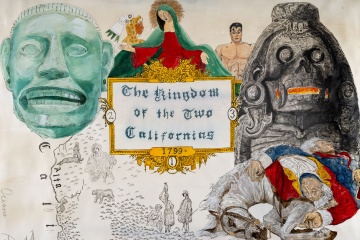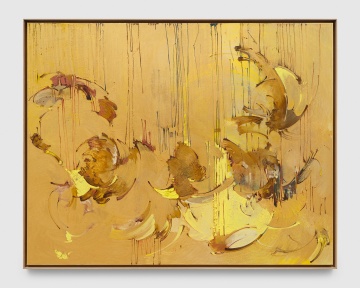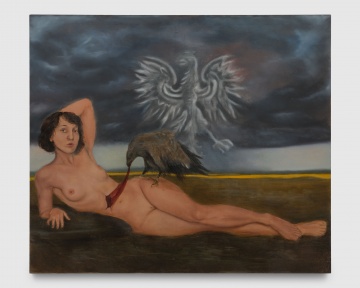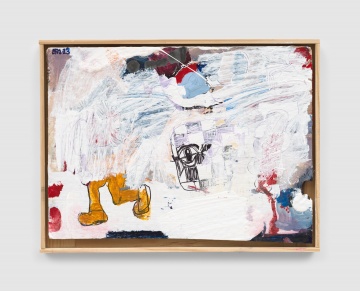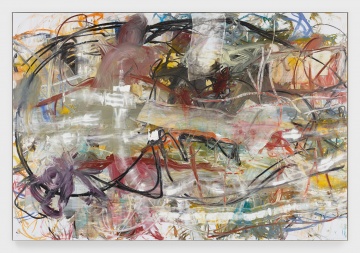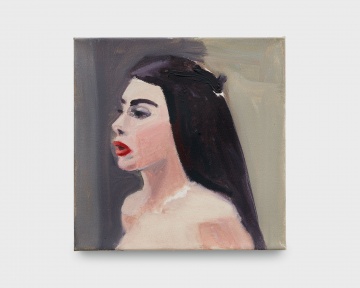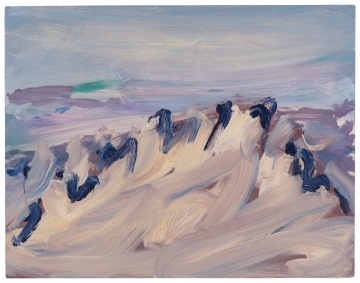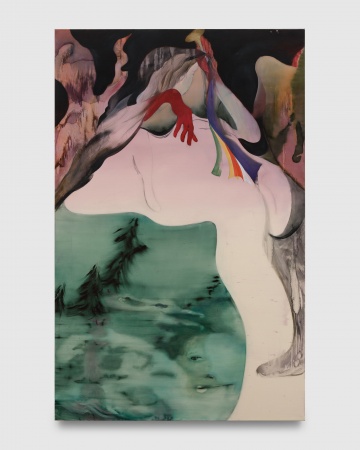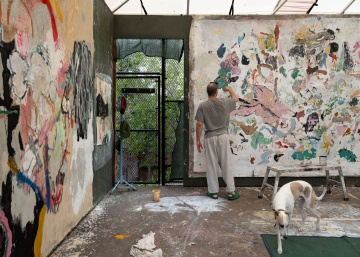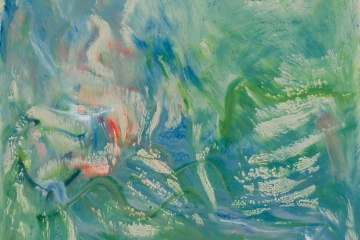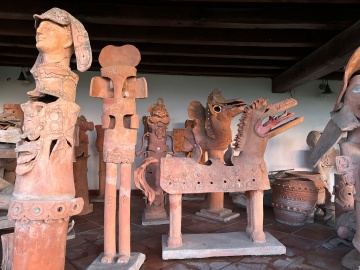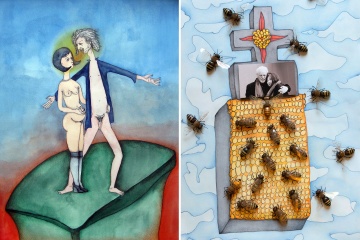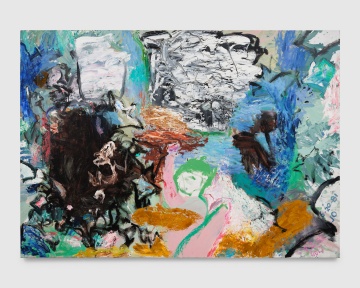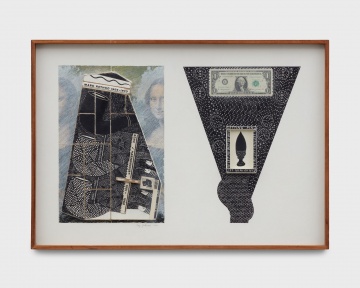BLUM
2727 South La Cienega Boulevard
Los Angeles, CA 90034
310 836 2062
Also at:
9 White Street
New York, NY 10013
Los Angeles, CA 90034
310 836 2062
Also at:
9 White Street
New York, NY 10013
BLUM represents more than sixty artists and estates from seventeen countries worldwide, nurturing a diverse roster of artists at all stages of their practices with a range of global perspectives. Originally opened as Blum & Poe in Santa Monica in 1994, the gallery has been a pioneer in its early commitment to Los Angeles as an international arts capital.
The gallery has been acclaimed for its groundbreaking work in championing international artists of postwar and contemporary movements, such as CoBrA, Dansaekhwa, Mono-ha, and Superflat, and for organizing museum-caliber solo presentations and historical survey exhibitions across its spaces in Los Angeles, Tokyo, and New York. Often partnering with celebrated curators and scholars such as Cecilia Alemani, Alison M. Gingeras, Sofia Gotti, Joan Kee, and Mika Yoshitake, the gallery has produced large-scale exhibitions focusing on the Japanese Mono-ha school (2012); the Korean Dansaekhwa monochrome painters (2014); the European postwar movement CoBrA (2015); Japanese art of the 1980s and 1990s (2019); a rereading of Brazilian Modernism (2019); a revisionist take on the 1959 MoMA exhibition, New Images of Man (2020); and a survey of portraiture through a democratic and humanist lens (2023); among others.
BLUM’s wide-reaching program includes exhibitions, lectures, performance series, screenings, video series, and an annual art book fair at its base in Los Angeles. BLUM Books, the gallery’s publishing division, democratically circulates its program through original scholarship and accessible media ranging from academic monographs, audio series, magazines, to artists’ books.
Across the three global locations, BLUM prioritizes environmental and community stewardship in all operations. In 2015, it was certified as an Arts:Earth Partnership (AEP) green art gallery in Los Angeles and consequently became one of the first green certified galleries in the United States. The gallery is also a member of the Gallery Climate Coalition, which works to facilitate a more sustainable commercial art world and reduce the industry’s collective carbon footprint. BLUM is committed to fostering inclusive and equitable communities both in its physical and online spaces and believes that everybody should have equal access to creating and engaging with contemporary art.
Artists Represented:
Alma Allen
Alma Allen
Theodora Allen
Tom Anholt
Karel Appel
March Avery
Darren Bader
Alvaro Barrington
Lynda Benglis
JB Blunk
Mohamed Bourouissa
Pia Camil
Robert Colescott
Thornton Dial
Carroll Dunham
Sam Durant
Kōji Enokura
Anya Gallaccio
Aaron Garber-Maikovska
Tomoo Gokita
Sonia Gomes
Françoise Grossen
Mark Grotjahn
Ha Chong-hyun
Kazunori Hamana
Christopher Hartmann
Julian Hoeber
Lonnie Holley
Yukie Ishikawa
Oliver Lee Jackson
Acaye Kerunen
Susumu Koshimizu
Friedrich Kunath
Yukiko Kuroda
Shio Kusaka
Kwon Young-woo
Tony Lewis
Linder
Florian Maier-Aichen
Eddie Martinez
Sadamasa Motonaga
Sam Moyer
Dave Muller
Kazumi Nakamura
Etsuko Nakatsuji
Yoshitomo Nara
Simphiwe Ndzube
Asuka Anastacia Ogawa
Kenjiro Okazaki
Anna Park
pascALEjandro
Solange Pessoa
Lauren Quin
Umar Rashid
Akane Saijo
Matt Saunders
Hugh Scott-Douglas
Nobuo Sekine
Peter Shear
Sebastian Silva
Agata Słowak
Kishio Suga
Ryan Sullivan
Alexander Tovborg
Yuji Ueda
Hiroka Yamashita
Yukinori Yanagi
Yun Hyong-keun
Zhu Jinshi

Gallery exterior. Courtesy of Joshua White and Blum & Poe Gallery, 2010.
Wilhelm Sasnal
AAAsphalt
May 30, 2025 - August 16, 2025
BLUM is pleased to present Polish artist Wilhelm Sasnal’s first solo exhibition with the gallery.
Resisting a singular painting style—abstractions edging in on dreamy figuration—for his first exhibition at BLUM, Wilhelm Sasnal explores the iconography and visual lexicon of the roadways of Southern California. Painting from photographs and sketches, Sasnal captures imagery from a brief time spent living in Los Angeles as a cyclist—someone intimately familiar with the texture, palette, and imagery of the region's thoroughfares. The resulting body of work shares themes with film noir—examining the complexities of black as a lack of color; these vignettes are all at once dramatic, brooding, and exhilarating.
After studying painting at the Academy of Fine Arts in Kraków, Sasnal set out to create paintings that undid the restrictive methodology associated with formal painting. Making work that was more about drawing with paint than painting and preferring graphic novels or record covers as his guidance over the Old Masters, Sasnal built his career around this idea of flipping painting on its head. This included bringing subjects rendered in black to the forefront of his compositions, thus reversing the guiding principles of chiaroscuro, a painting fundamental that harks back to the Renaissance and Baroque periods.
Presently, Sasnal is an avid pupil of the art historical canon—taking inspiration from and pushing back against a wide array of sources, such as Edgar Degas and Sigmar Polke—but his enthusiasm for this discourse is still laced with a persistent contrarian spirit. Retaining a fixation on black as a pause for the eye in traditional compositions, Sasnal asserts stripes of black paint—a compositional rest—atop the busyness of landscapes rendered in pale color. In All American (2025), for instance, the work’s titular words float amid the desert horizon as if roads were paved in midair.
Asphalt takes a paramount position in this exhibition, both for its physical characteristics and conceptual implications. Sasnal immerses himself in the many facets of this substance, becoming absorbed in it in the intimate way that only a cyclist could. When he conveys his findings, it is with the sensibilities of an artist who is keenly attuned to semiotics, color theory, depth, and perspective. For its external implications, Sasnal notes that asphalt is made of petrol, which gestures at a wealth of global issues. Asphalt also contains a complex spectrum of black, which Sasnal expresses through a range of gestures from snaking abstract lines to solid-edged blocks of pigment. Roads are also notable for their traditional usage in perspective, requiring only two receding lines and a horizon point to express depth.
Sasnal paints in a medium-specific manner, but his mode of culling subject matter is multidisciplinary. Archiving and reflecting culture’s nuances back upon itself, in this exhibition, Sasnal took photographs, kept a sketching practice, and borrowed typeface while collecting notable moments or ideas for future paintings. The works Palmdale 1 and Palmdale 2 (both 2025), for instance, are painted from photographs that the artist took streetside while cycling. Noticing the presence of several fighter jets parked just within the parameters of a military base near Palmdale, California, the artist recorded this unexpected and ominous encounter with his camera. Later, when creating his compositions for each work, these massive weapons become abstracted, shadowy figures to convey and isolate the unique feeling imparted upon the viewer when seeing the original. With his brush to canvas acting as the lens through which these found talismans of our society are given meaning, Sasnal is not merely a documentarian but also a philosopher of the overlooked.
Tomoo Gokita
NAKED
May 30, 2025 - August 16, 2025
BLUM is pleased to present NAKED, an exhibition of new paintings by Tokyo-based artist Tomoo Gokita. This is the artist’s third solo exhibition with the gallery.
Known for his uncanny approach to figuration, Gokita has long explored the tension between familiarity and distortion in his psychologically charged compositions. Working in both monochrome and vibrant colors, he has built a distinctive visual language that merges portraiture, abstraction, and cultural memory. Early works often originated from found imagery—vintage magazines and old newspapers—serving as visual springboards that he would intuitively warp and reimagine through his tactile process of painting.
In recent years, however, Gokita has shifted his practice inward. No longer relying on pre-existing media, he channels his subjects from memory and subconscious invention. The resulting forms—part-human, part-fantastical—occupy a liminal space between reality and dream. His characters now take shape through layers of erasure and reinvention. This iterative approach allows each figure to exist as a collision of gestures, influences, and emotional states, invoking artists from Picasso to Guston while conjuring the spectral strangeness of sci-fi cinema and surrealist dreamscapes.
With NAKED, Gokita turns his attention to the trope of the female nude, reframing a historically overdetermined subject with acidic irreverence and grotesque beauty. In these paintings, Surrealist bodies bristle with defiant physicality, eschewing objectification in favor of confrontational agency. Referencing the glamor of Playboy, the weirdness of B-movie aesthetics, and the compositional motifs of Impressionist painting, these nudes are saturated with intense, unsettling color. At once seductive and disquieting, titles such as PEEPING WOMAN (2025), THE BABY-SITTERS CLUB (2025), and THE BALCONY INCIDENT (2025) hint at uncanny and humorous narratives, infusing the work with irony, unease, and a self-assured rejection of conventional beauty.
Unending Spiral
Sarah Rosalena
May 30, 2025 - August 16, 2025
BLUM is pleased to present Unending Spiral, Los Angeles-based artist Sarah Rosalena’s second solo exhibition with the gallery. This presentation coincides with the unveiling of Rosalena’s major public artwork commissioned by the Los Angeles County Museum of Art this June, and the artist’s participation in exhibitions at the Dallas Contemporary and Museum of Contemporary Art San Diego. She was recently featured in six exhibitions for the Getty’s PST ART: Art x Science Collide.
Operating at the intersection of traditional craft and advancing technology, Rosalena’s work combines Wixárika weaving techniques, taught to her by her mother and grandmother, with technical processes such as ceramic 3D printing and digital weaving. Similar to computational language, weaving consists of a series of dualities—warp and weft, over and under—which behave similarly to the 0 and 1 binary of code. By giving form to this shared logic in her woven textiles and baskets, it is possible for Rosalena to physicalize and interrogate the technological scaffolding underneath.
Unending Spiral examines the structural and conceptual implications of the spiral as both a formal strategy and a conceptual framework, drawing parallels between galactic formations and terrestrial craft traditions in textiles, coiled ceramics, and basketry. By employing materials of the earth—hand-dyed pine needles, clay, and fiber—Rosalena grounds her work in tactile, site-responsive processes while simultaneously engaging digital technologies with her hand. The pine needles are naturally dyed in plants such as cochineal, walnut, and onion skin, producing a living palette. These material disruptions interrogate the hierarchies that have historically positioned Indigenous craft in opposition to digital methodologies, proposing instead a continuum in which traditional knowledge and emerging technologies co-generate one another, revealing the spiral as a structure of persistence, recursion, and self-perpetuation.
Using digital images of spirals in nature, such as spiral arms of galaxies—Rosalena translates these celestial bodies into handwoven patterns and coiled forms. Her 3D-printed ceramic vessels simulate the process of traditional coil building, yet they resist containment; partway through, the ceramic coils give way to handwoven pine needle basketry, a material intervention that disrupts technological precision with the irregularities of the organic. By positioning the spiral as a recursive, non-linear structure, Unending Spiral challenges dominant narratives of progress, which privilege forward motion and technological advancement over cyclical, regenerative knowledge systems, foregrounding craft as a site of critical resistance and epistemological expansion. Through these hybrid forms, Rosalena posits an alternative material cosmology—one that is iterative, interwoven, and perpetually in infinite motion.
Adam Silverman
LACMA Seeds and Weeds
May 30, 2025 - August 16, 2025
BLUM is pleased to present LACMA Seeds and Weeds, Los Angeles-based artist Adam Silverman’s first solo exhibition with the gallery.
Continuously finding new ways to address the idea of place through his mastery of the ceramic medium, Silverman has turned to the construction site of the forthcoming Los Angeles County Museum of Art (LACMA) building, designed by Peter Zumthor, for his latest source of inspiration. Collecting remnants such as tar, clay, and felled bamboo trees, the artist processes these tokens into the final constitution of each vessel.
Receiving degrees from the Rhode Island School of Design in both Fine Arts and Architecture, the spatial and structural awareness of Silverman’s artistic output is palpable. As much about their own construction as their relationships to their surroundings, Silverman’s vessels are often presented as elements of a larger installation that also engages its environment—highly considered parts of a whole within a contingent context. After his studies, while doing a residency in ceramics in Mashiko, Japan—known for its rich ceramic tradition—Silverman observed and utilized the local clay that people from this region had been working with for centuries. Those familiar with the traditional vessels from Mashiko would recognize the distinctive style and finish that results, in part, from chemical reactions when firing the iron and silicic acid that naturally occurs in the ground there. It was in Japan that Silverman began examining the connections between pottery’s geological properties and place, but it wasn’t until later that he would begin exchanging geological indicators with cultural meaning in his process.
It was while working on a site-specific installation for the Kimbell Art Museum in Fort Worth, Texas, that Silverman first utilized materials excavated from a cultural site to build his vessels. Intrigued by the convergence of two of his favorite architects, with Renzo Piano’s addition to Louis Kahn’s original museum building, Silverman wanted to create something that encapsulated the physical overlap between these two great cultural forces. Similarly, Silverman saw the construction site of Zumthor’s LACMA building abutting the historically rich La Brea Tar Pits within the heart of the city as a distinct moment of institutional, architectural, biological, and geological relevance that could be preserved through the ceramic medium.
LACMA Seeds and Weeds concretizes a transition for Los Angeles—wherein land that has acted as a gathering point, providing the city a glimpse into its prehistoric past, is peppered with unique properties as a new structure takes its place there. Utilizing materials from the construction zone as part of his medium to create the effect of his finished works, Silverman conceptually honors the many stages of the history of this place in his objects. Carefully searching the LACMA building’s dig site, Silverman found deposits of tar bubbling up from the ground alongside deposits of natural clay. Bringing these substances back to his studio, he processed them—using tools such as a mortar and pestle—into a specific mixture that he utilizes to create the finish of his “seed” and “weed” vessels presented here.
As their name indicates, Silverman’s “seed” and “weed” vessels could almost have cropped up in their location, as that is what the ingredients of their makeup had done. It is Silverman whose expertise allows their specific existence—with a meticulous process that might include multiple firings, restricting airflow to the kiln, or blowing ash on vessels to achieve each work’s unique finish. It is through a combination of what the LACMA site provides and what Silverman alone can cultivate that each work comes into being.
For the work in LACMA Seeds and Weeds, Silverman’s glazes are all made from different combinations of the following ingredients collected from LACMA: wood ash (gallery floors, trees, construction lumber, and debris), concrete, travertine, ceramic tiles, glass, stones, red iron oxide (made from rusty metals found on the site), soda ash, clay, and tar.
Robert Colescott
The Anansean World of Robert Colescott, Curated by Umar Rashid
April 5, 2025 - May 17, 2025
The Anansean World of Robert Colescott
Curated by Umar Rashid
BLUM Los Angeles
April 5–May 17, 2025
Saturday, April 5
4pm: Public conversation with Sandra Jackson-Dumont and Umar Rashid, moderated by
JJ Strawn
5–7pm: Opening reception
BLUM is pleased to present an exhibition of paintings and drawings by the late artist Robert Colescott, curated by Los Angeles–based artist Umar Rashid. Rashid frames this presentation of work—ranging five decades—as an entry point into The Anansean World of Robert Colescott, a parallel universe that violates principles of social and natural order, blithely disrupting what once was and then reestablishing it on a new basis. In the time of the ancient deities, the trickster was the only one who could successfully navigate the complex and morally fraught universe of power-hungry, vengeful, wickedly jealous, and ambivalent gods, as well as their equally maligned human counterparts. One can only imagine the path of Thoth, Hermes, Coyote, Dionysus, Loki, Prometheus, and the original spider-man, Ananse. Although there are far more “tricksters” woven into our collective human consciousness throughout time, I have kept the list relatively short so that I may get to the point. Despite being tasked with delivering various decrees on this and that, the messengers of the gods of old almost always had a penchant for mischief, high drama, and outright rebellion. And despite these “faults,” they managed to survive the wrath of their omnipotent masters and formed a complex relationship with their painfully mortal audience. Their legacy as “middle management” and mere couriers left an indelible mark on their human charges. With the death of the old pantheon, humanity’s hubristic and equally chaotic reign, produced its own gods, monsters, and tricksters, bringing to mind the old saying, “As above, so below.”
And thus, we enter the world of Robert Colescott, grand trickster of the ages. The appellation is incredibly apt in terms of his artistic practice, yet he was not born thus but forged through the crucible of being an African American fine artist in a time of limited opportunity for those like him and the ideas he sought to bring forth in a postindustrial world, burdened by draconian racial awareness, social lobotomization, and post-imperial, imperial war machinations. This is mid-twentieth-century America, replete with all the trappings of Mount Olympus at its zenith. — Umar Rashid
Robert Colescott (b. 1925, Oakland, CA; d. 2009, Tucson, AZ) was a proud instigator who, over a
nearly six-decade painting career, fearlessly tackled subjects of social and racial inequality, class
structure, sex, and the human condition through his uniquely rhythmic and often manic style of
figuration. His distinctive works, while not easily placed within any one specific school of painting,
share elements of Abstract Expressionism, Pop Art, "Bad" Painting, Renaissance Painting, Neo-
Expressionism, and Surrealism. A retrospective curated by Lowery Stokes Sims and Matthew Weseley,
opened at the Contemporary Arts Center, Cincinnati, OH, in 2019, and later traveled to the Portland Art
Museum, Portland, OR; Sarasota Art Museum, Sarasota, FL; Chicago Cultural Center, Chicago, IL; and New Museum, New York, NY. The exhibition was accompanied by a comprehensive monograph on the artist’s life and work, published by Rizzoli Electa.
Colescott’s work is represented in public collections internationally, in such notable institutions as the
Akron Art Museum, Akron, OH; Art Bridges Foundation, Bentonville, AR; Baltimore Museum of Art, Baltimore, MD; Brooklyn Museum of Art, Brooklyn, NY; BY ART MATTERS, Hangzhou, China; California African American Museum, Los Angeles, CA; Corcoran Gallery of Art, Washington, D.C.; Crocker Museum of Art, Sacramento, CA; Dallas Museum of Art, Dallas, TX; Delaware Museum of Art,
Wilmington, DE; Denver Museum of Art, Denver, CO; Detroit Institute of Arts, Detroit, MI; de Young Fine
Arts Museums of San Francisco, CA; Hammer Museum, Los Angeles, CA; High Museum of Art, Atlanta, GA; Hirshhorn Museum & Sculpture Garden, Washington, D.C.; Los Angeles County Museum of Art, Los Angeles, CA; Lucas Museum of Narrative Art, Los Angeles, CA; Manetti Shrem Museum of Art, UC Davis, CA; Metropolitan Museum of Art, New York, NY; Morgan Library and Museum, New York, NY; Museum of Contemporary Art, Los Angeles, CA; Museum of Contemporary Art, Chicago, IL; Museum of Fine Arts, Boston, MA; Museum of Modern Art, New York, NY; National Gallery of Art, Washington D.C.; Oakland Museum of California, Oakland, CA; Portland Museum of Art, Portland, OR; Pinault Collection, Paris, France; Rubell Family Collection, Miami, FL; San Francisco Museum of Modern Art, San Francisco, CA; Seattle Art Museum, Seattle, WA; Studio Museum in Harlem, New York, NY; Tucson Museum of Art, Tucson, AZ; Wadsworth Atheneum Museum of Art, Hartford, CT; Walker Art Center, Minneapolis, MN; Whitney Museum of American Art, New York, NY; among many more.
Umar Rashid (b. 1976, Chicago, IL) creates paintings, drawings, and sculptures that chronicle the grand historical fiction of the Frenglish Empire (1648–1880) a conceptual world he has been developing for over seventeen years. Each work represents a frozen moment from this parallel history, often recalling fraught real-world narratives—both canonized and marginalized—with familiar signifiers and iconographies. Rashid’s work channels the visual lexicons of hip hop, ancient and modern pop culture, gang and prison life, and revolutionary movements throughout time. Rashid’s work is represented in the public collections of the Brooklyn Museum, Brooklyn, NY; Hudson River Museum, Yonkers, NY; Jorge Pérez Collection, Miami, FL; Mount Holyoke Art Museum, South Hadley, MA; Nevada Museum of Art, Reno, NV; Ruth and Elmer Wellin Museum of Art at Hamilton College, Clinton, NY; Santa Barbara Museum of Art, Santa Barbara, CA; Wadsworth Atheneum Museum of Art, Hartford, CT; and the Zeitz Museum of Contemporary Art Africa, Cape Town, South Africa, among others.
Kazuo Kadonaga
April 5, 2025 - May 17, 2025
BLUM is pleased to present an exhibition of sculptures by Japanese artist Kazuo Kadonaga.
Kadonaga was born in 1946 in Ishikawa, Japan, to a family of forestry professionals. Deviating from intergenerational tradition, the artist chose a more creative path—initially pursuing painting before returning to his father’s sawmill for the inspiration behind a lifelong, sculptor-based practice. Aligning himself with the influence of Arte Povera, Mono-ha, and Gutai, Kadonaga’s works emphasize the material from which they are brought forth. Through meticulous interventions, the artist emphasizes the natural state of his subjects.
Umar Rashid
The Kingdom of the Two Californias. La Época del Totalitarismo Part 2.
November 2, 2024 - December 21, 2024
BLUM Los Angeles
November 2–December 21, 2024
Opening Reception: Saturday, November 2, 5–7pm
Opening Day Event: Umar Rashid in Conversation with Mika Yoshitake, 4pm
As part of PST ART: Art & Science Collide, BLUM is pleased to present Los Angeles-based artist Umar Rashid’s third solo exhibition with the gallery, The Kingdom of the Two Californias. La Época del Totalitarismo Part 2. This second installment of Rashid’s Epoch of Totalitarianism series rejoins the artist’s fictional Frenglish conquerors in the 1800s as they attempt to maintain a stronghold in the Americas. Bearing an undeniable resemblance to the history of the Spanish Empire in the Californias, the monstrous power of colonialism is emphasized by Rashid as he portrays the Frenglish with otherworldly militant advantages from the science fiction genre.
Kaifan Wang
One Piece
November 2, 2024 - December 21, 2024
FOR IMMEDIATE RELEASE
Kaifan Wang
One Piece
BLUM Los Angeles
November 2–December 21, 2024
Opening Reception: Saturday, November 2, 5–7pm
Opening Day Event: Gold Amidst Dust contemporary dance performance by artists Gema Galiana and Emily Meister, 5:30pm
October 24, 2024, Los Angeles, CA—BLUM is pleased to present One Piece, Berlin-based artist Kaifan Wang’s first solo exhibition with the gallery.
There is a nomadic underpinning to the way that Wang thinks—this mindset sentimentally unifies the artist’s practice as well as this exhibition. Born in Hohhot, China, an area with a long cultural history that has been buried by rapid urban development, and living in Berlin, Wang is a masterful and worldly storyteller with the unique ability to find overlap between the histories of the Chinese diaspora and the preexisting narratives embedded within the places where he lives or works. For Wang, migration is a means of traversing cultural references across time and space to find meaning in the now.
The artist draws out disparate references and discursively relates them to one another in surprising ways. Wang nods, for instance, to emigrants from Inner Mongolia through the movement and gestures in his paintings—some strokes moving along the pull of gravity or the natural flow of the composition and others moving against. Bearing in mind the stark contrast between the history of Chinese and Western abstract painting, Wang’s style ruminates on fractured cultural identities and the fluidity of human migration through flowing gestures and plumes of oil, oil stick, and acrylic on canvas—offering conclusions at once intellectual and emotive on a topic that is otherwise quite slippery.
While doing research for One Piece, Wang visited Gustav Klimt’s Beethoven Frieze (1901–1902), a mural commissioned for the Secession Building in Vienna, Austria in which Klimt depicted Wagner’s literary interpretation of the swelling crescendos and opulence of Beethoven’s 9th Symphony as an expression of desire. As though with a gold thread, Wang draws unlikely parallels between the gold of Klimt’s goldleaf, the sandstorms of the artist’s childhood, and the gold rush that drew in the first generation of Chinese migrants to the United States. Here, gold becomes the intersection of desire and personal memories.
Wang’s painting Gum Shan (2024), for instance, takes its title from a Cantonese name given to San Francisco that translates to “gold mountain.” Gum Shan captures Wang’s vivid visions of the glimmer of hope that might motivate nineteenth Chinese prospectors arriving in California to mine gold—encouraged to marry and have children, sometimes just months away from their departure dates, they were meant to work hard and send their profits back home. As Wang puts it, “The inherent contradiction in the relationship between searching and desire is bondage.” The yearning for happiness can be a yoke along the path to autonomy.
One Piece, a Japanese manga and animation, is a story of risk-taking, adventurous seafarers, each representing different civilizations and spirits. All characters in this tale are driven to find the ultimate treasure of a fabled prize known as the one piece—although its nature is shrouded in mystery, this treasure unifies the characters in a common trajectory. This idea pervades Wang’s practice, apparent in the fusion of his vast array of references as well as each individual story. Reverse Mountain (2024) is a surrealist landscape. Its water flows upward along a golden mountain range toward the important gateway to the New World. Calm Belt (2024) is the impediment posed toward those who want to enter this same world. In this peaceful vignette, there is neither wind nor currents that could propel a ship toward successful passage to the coveted destination.
One Piece coincides with the release of Kaifan Wang’s first monograph. Eponymously titled, this in-depth exploration of the artist’s practice features essays by Xiaoyu Weng, Martin Herbert and Marta Gnyp.
Kaifan Wang (b. 1996, Hohhot, China) lives and works in Berlin, Germany. He studied in Shanghai and Florence before completing his Fine Arts education at the Universität der Künste, Berlin, Germany in 2022. Wang has exhibited his work in prominent group exhibitions, including Supercrowds/Super community, TANK Shanghai, China (2024); Bordercrossing: Possibilities and Interactions, Yuz Museum, Shanghai, China (2023); Briefly Gorgeous, Songwon Art Center, Seoul, South Korea (2023); Temporary Chapter, Wilhelm Hallen, Berlin, Germany (2022); Caused BY Hair, Shanghai Himalayas Museum, Shanghai, China (2019); and FLUXUS+Studios, FLUXUS+ Museum, Potsdam, Germany (2019). Wang was featured in Influential 2023: Forbes China Contemporary Young Artists and won the Ivan Juritz Prize 2022, funded by King’s College London and Mahler & LeWitt Studios in Spoleto, Italy. He also received the HVB KunstCUBEs One-Year Artist Grant. The first monograph of his work will be released in October 2024.
About BLUM
BLUM represents more than sixty artists and estates from seventeen countries worldwide, nurturing a diverse roster of artists at all stages of their practices with a range of global perspectives. Originally opened as Blum & Poe in Santa Monica in 1994, the gallery has been a pioneer in its early commitment to Los Angeles as an international arts capital.
The gallery has been acclaimed for its groundbreaking work in championing international artists of postwar and contemporary movements, such as CoBrA, Dansaekhwa, Mono-ha, and Superflat, and for organizing museum-caliber solo presentations and historical survey exhibitions across its spaces in Los Angeles, Tokyo, and New York. Often partnering with celebrated curators and scholars such as Cecilia Alemani, Alison M. Gingeras, Sofia Gotti, Joan Kee, and Mika Yoshitake, the gallery has produced large-scale exhibitions focusing on the Japanese Mono-ha school (2012); the Korean Dansaekhwa monochrome painters (2014); the European postwar movement CoBrA (2015); Japanese art of the 1980s and 1990s (2019); a rereading of Brazilian Modernism (2019); a revisionist take on the 1959 MoMA exhibition, New Images of Man (2020); and a survey of portraiture through a democratic and humanist lens (2023); among others.
BLUM’s wide-reaching program includes exhibitions, lectures, performance series, screenings, video series, and an annual art book fair at its base in Los Angeles. BLUM Books, the gallery’s publishing division, democratically circulates its program through original scholarship and accessible media ranging from academic monographs, audio series, magazines, to artists’ books.
Across the three global locations, BLUM prioritizes environmental and community stewardship in all operations. In 2015, it was certified as an Arts:Earth Partnership (AEP) green art gallery in Los Angeles and consequently became one of the first green certified galleries in the United States. The gallery is also a member of the Gallery Climate Coalition, which works to facilitate a more sustainable commercial art world and reduce the industry’s collective carbon footprint. BLUM is committed to fostering inclusive and equitable communities both in its physical and online spaces and believes that everybody should have equal access to creating and engaging with contemporary art.
Press Inquiries
Nicoletta Beyer
Communications and Editorial Director, New York
nicoletta@blum-gallery.com
Christie Hayden
Communications and Social Media Editor, Los Angeles
christie@blum-gallery.com
Agata Słowak
SZTUKĄ DIABŁA TŁUKĄ
November 2, 2024 - December 21, 2024
FOR IMMEDIATE RELEASE
Agata Słowak
SZTUKĄ DIABŁA TŁUKĄ
BLUM Los Angeles
November 2–December 21, 2024
Opening Reception: Saturday, November 2, 5–7pm
BLUM is pleased to present SZTUKĄ DIABŁA TŁUKĄ, Warsaw-based artist Agata Słowak’s first solo exhibition with the gallery.
Alison M. Gingeras, curator and writer based in New York and Warsaw, sits down with Agata Słowak to discuss the influences and themes that have shaped her latest works.
Alison M. Gingeras: Last time I was in your studio, right before you sent the paintings to Los Angeles, I was simultaneously impressed by the new elements in your work and the consistent through-line of self-portraiture that you continue to practice. With each canvas, you’re pushing the genre further, which I think will be quite evident in the grouping of eight you will show in LA.
One thing that I noticed was your collection of porn magazines you had spread all over the floor. These aren’t just any old porn magazines—they are super specific to Poland’s history and to the radical social changes that took place during the transition from Communism to Capitalism in the early 1990s. Why did you start collecting those? How have those images transpired upon your new works? Why are they compelling for you? So many of your new dynamic narrative compositions are perhaps coming from those magazines?
Agata Słowak: These are not randomly selected magazines! These Polish erotic magazines from the 1990s interest me on several levels. What fascinates me is a certain kind of nostalgia (I was a child during this transition period, so obviously, I wasn’t aware of its gravity). These magazines are aesthetically and distinctively pre internet, so they’re noteworthy. More significantly, they were being published at a moment when people began talking about sexuality in Poland. In the times of the Communist Polish People’s Republic, Poles’ sexuality was suppressed and superficial, an important social trend that was reinforced by the dominance of the Polish Catholic Church.
These porno mags are also incredibly interesting visually, due to their naturalism and the limitations of resources at the end of the last century; there is no retouching, no plastic surgery, and virtually no access to professional make-up artists. The photo editorials depict “real” people, paradoxically, somewhat escaping the patriarchal canon of beauty. They’re a wonderful time capsule, bearing imperfections at different ages, social structures, and sexual orientations.
And apart from this type of inspiration, these magazines make great reference material for models! We find expressive ready-made body arrangements that are fantastic for dressing up in compositions and painting—these photos are not easy to find on the internet today. The images are very niche and have a strong character of time and place, making them unique.
AG: Another striking departure in this work is the appearance of more direct symbolism. Can you talk a bit about the Polish Eagle that appears in one of your self-portrait nudes, Polka / Jaki kraj taka Prometeusza // Pole / Such a Country Such a Prometheusess (2024)? There have always been some sly elements of Polish identity in your works—very codified landscapes, Catholic references, rural settings—but the Polish Eagle is such a monumental and official signifier. I’m wondering what prompted you to insert such a loaded symbol into one of your recent tableaus.
AS: The work with the eagle was created during the holidays, when I was visiting the region where I grew up. I came across the small village of Zalipie, where I discovered wooden houses painted by a women’s guild. One of them had an eagle made of pinecones—it was all based on a strong sense of Polish identity; I felt something native about it, something unique. I also don’t like it when symbols related to patriotism are appropriated bythe conservative side, nationalists, and right-wingers. I believe that representatives of minorities also have a civil right to these symbols.
AG: There are so many indelible images that stuck with me during our studio visit. The lady humping a cactus, pictured in Down in Mexico (2024), was one of the most memorable images that haunted me. Can you tell me about this picture? Who is she? I feel this is an allegory, but I would love to hear your narration around this stunning work.
AS: In a way, it’s about the strength of this woman; I wanted to visualize the increasing desire for a certain insatiability and think about the limits of the strongest orgasm. Is there a limit? This cactus can express something seemingly strong, giving strength and security, such as a man with a strong position, a prize in a competition, and such. This painting is actually not quite my style— the Mexican atmosphere is a real departure, but I just wanted to paint this strong motif.
AG: The appearance of “non-finito” is a new element in your forthcoming show. I very much liked these deliberately unfinished, rather gestural paintings. And I particularly liked seeing them hanging side by side with your more “classical” signature style of this renaissance technique, deploying layers of underpainting that you usually utilize. The tension is super interesting, and to me, the images feel a bit like the remnants of dreams...how one remembers strong dream-images without recalling the storyline or only fragments that float in the haze of your memory when you wake up. Is that something you were thinking about at all?
AS: I’ve long been drawn to the unfinished, as a conscious decision. Both in the contrast of the detail, such as a portrait and the background, as well as in a certain type of gestural painting technique. I don’t want to give up on overworked narratives that have many layers and are built slowly on the canvas—but expressive, intentionally unfinished works allow the concept to remain fleeting and have a dreamlike expression. The concept of combining this gesture with sleep is beautiful and seems extremely accurate to me. What remains from intense sleep is essence and fragmentation.
AG: Dream space is a major trope in your work, not only in these hazy, fractured images but also in the sense that certain themes and symbols reoccur frequently. One such theme that is in this new body of work, and also very present in previous works, is the question of reproduction. The possibility of procreation, your internal struggle with potential motherhood, the desire and repulsion of childbirth, the visceral depiction of the body as a potential vehicle for reproduction: the question of having a child seems to haunt you. And like with dreams, the recurrence of childbirth imagery is both consistent and shifting in your work, from paintingto painting. It is as if reproductive justice and the maternal compulsion seem to be in conflict in your work—just as they are in our socio-political sphere?
AS: You’re right that painting can emerge from that part of consciousness as dream fantasies. There are people and motifs that come back to us from the subconscious, relationships and themes that seem to organize our lives, hanging over us like ghosts. The topic of reproduction is extremely vivid and topical for me, and I’m not just talking about the current political fight for abortion rights, just personal dilemmas arising from the opportunity my own body potentially gives me. How many life-shaping decisions resulted from the very fact that such a choice is a viable option? We feel the pressure of a ticking clock. Since it doesn’t happen passively, how should one make a decision? When? With whom? And how, so as not to miss out on commitments and work? On the one hand, one can be a mother of art and treat it as one’s relationship and offspring, accepting that perhaps there are other things one is called to do, opposed to most people. On the other, there’s the feeling that one is giving up such an intense experience in life. Freedom and independence have their weak points here. Painting only perpetuates this lack of answers. On the one hand, the atmosphere of the family home is a simple expectation of a physical extension of life. On the other, there’s the devastating fear that accompanies a late period—that despite being sexually driven, the person isn’t ready for parenthood, and that the creative state would be ruined.
Agata Słowak (b. 1994, Busko-Zdrój, Poland) paints audacious pictorial narratives with a disarming, Old Master-stylistic flair. Whether appearing alone or in group tableaus, Słowak’s youthful mien engages the viewer with the same defiant yet serene gaze. The artist is almost always the protagonist of her scenes that surpass conventional self-portraiture and tasteful subject matter with their allegorical density. Perfumed with a radical strain of feminism, her compositions are overloaded with Catholic iconography, Neoclassical art allusions, visceral bodily fluids, and graphic sexual acts. Her canvases manifest a relentless need to probe the intersection of her personal desires and collective political struggles. Słowak has received recognition since her recent arrival on the international art scene. Her work has been presented at the Zachęta National Gallery of Art (2022) and the Museum of Modern Art, Warsaw (2021, 2019), among other institutions and galleries.
Eddie Martinez
Homework
September 14, 2024 - October 19, 2024
BLUM is pleased to present “Homework,” Brooklyn-based artist Eddie Martinez’s third solo exhibition with the gallery.
Completed at a compact and intimate scale, the paintings on cardboard that comprise “Homework” function for Martinez as visual journal entries from recent years. Beginning to work in this fashion in 2017, the artist started creating these diaristic vignettes as an alternative to the large-scale canvases he had become most known for. As this portable fusion of drawing and painting grew into a regular practice, Martinez found that the format was one he could turn to in moments of transition—whether at home with his family (and an abundance of shipping boxes during the pandemic in 2020) or, more recently, amid work-related travel.
Innovating beyond mere mimesis of floral arrangements or butterflies, for example, the originative works in this show utilize mixed media such as Sharpie, acrylic, or colored pencil to great poetic effect. Deploying these universal symbols or autobiographical forms as spatial guides and timeless art historical analogies, Martinez uses his representational elements as trojan horses to draw the viewer’s eye to the sturdy brushstrokes and striking abstractions contained therein. Close inspection reveals an abundance of joyful gestures of varying weight and media—block colors of paint play off delicately drawn lines to recall the conditions of their own making and the artist’s hand.
A key facet of all the works presented here are the handmade artist’s frames on which Martinez often continues his compositions. Behaving as extensions of these paintings—rather than calling attention to their boundaries—each frame metaphorically signals to its viewer how the making of these works stretches beyond the bounds of Martinez’s studio practice and into his everyday life. The exhibition’s title is another indicator of this same idea, with “Homework” referencing both the standard task of students and the paintings that Martinez made in his home during the early stages of the COVID-19 pandemic.
Made between 2020 and 2024, “Homework” sees Martinez through a global moment of vicissitude and eventual return to an altered state of normalcy. Each utilizing distinctly different palettes, subject matter, and media, these works hint at being confessional—prompting inquisitions in the viewer as to what points of inspiration or circumstances might have enacted changes between one vignette and the next. Always playing by his own rules, in “Homework,” Martinez pivots from black and white to color or abstraction to figuration, though, maintains his effervescent style and obvious fervor for artistic expansion.
Eddie Martinez (b. 1977, Groton Naval Base, CT) lives and works in Brooklyn, NY. Martinez’s works has been the subject of numerous institutional solo shows, including “Buflies,” Parrish Art Museum, Watermill, New York (2024); “Nomader,” curated by Alison M. Gingeras, Pavilion of the Republic of San Marino, La Biennale di Venezia, Venice, Italy (2024); “To Be Continued,” Space K, Seoul, South Korea (2024); “Fast Eddie,” Museum of Contemporary Art Detroit, MI (2019); “Open Feast,” Yuz Museum, Shanghai, China (2019), “White Outs,” Bronx Museum of Arts, Bronx, New York (2018); and “Studio Wall,” The Drawing Center, New York, NY (2017). His works are represented in international public collections including the Aurora Museum, Shanghai, China; Bronx Museum of Arts, Bronx, NY; Carnegie Museum of Art, Pittsburgh, PA; Davis Museum at Wellesley College, Wellesley, MA; Marciano Collection, Los Angeles, CA; Morgan Library, New York, NY; Museo de Arte de Puerto Rico, San Juan, Puerto Rico; Museum of Contemporary Art, San Diego, CA; National Gallery of Art, Washington D.C.; RISD Museum, Providence, RI; Saatchi Collection, London, UK; and the Yuz Museum, Shanghai, China, among others.
Aaron Garber-Maikovska
Side Walk in Bdrrrrrrr Major
September 14, 2024 - October 19, 2024
BLUM is pleased to present Los Angeles-based artist Aaron Garber-Maikovska’s third solo exhibition with the gallery.
Taking the grids and unlikely landmarks of the late capitalist suburban landscape as his sources of inspiration, Garber-Maikovska paints abstract marks of oil on fluted polypropylene or canvas that recall the artist’s ongoing performance practice. These motion-based works that Garber-Maikovska stages and subsequently draws upon for his paintings behave as if the semiotics of an avant-garde visual language met the controlled aleatory inherent to the compositions of John Cage. Garber-Maikovska enacts somatically channeled movements within, and attuned to, spaces of hyper-consumption such as the parking lot of a Target. Similarly, the uniquely manufactured plastic apparatuses by which Garber-Maikovska applies, spreads, and rakes his pigments create lines that appear to pulse with the variable rhythm of a metro area.
Of this body of work and his process behind it, the artist says, “Wield the landscape as an instrument of play.” Garber-Maikovska does not keep a sketching practice, as many artists do while preparing to paint. Rather, as with the Situationists gathering information through a dérive or urban meander, Garber-Maikovska accrues inspiration for his paintings via his exploratory performances outside the studio. He then brings his findings back to be exuded onto his substrates.
The grid is fundamental to both city planning and to the history of painting. The sheets of fluted poly that Garber-Maikovska paints on have their own intrinsic grid; line after line runs parallel beside the other to create the structure of this material. The resulting imprint of this pattern can be detected in each of the artist’s paintings. Even when working on canvas, Garber-Maikovska will place a sheet of poly underneath and press his gestures upon the two. Issuing a measured finish that also emulates the cadenced pace of Garber-Maikovska’s somatic, time-based work, this texture is recurrent throughout the exhibition.
Another property of Garber-Maikovska’s fluted poly is its penchant for resisting paint. The observer sees this in the way that the artist’s hand slides across his surfaces, both dispersing and removing pigment as he goes. With uniquely manufactured tips of varying width affixed to his tubes of paint or with bars of color meticulously produced within his studio, each tool in Garber-Maikovska’s repertoire correlates to a particular kind of gesture in his visual vernacular. Just as the motions in his performances hinge on a form of regimented chance operations, so too do the individual marks within Garber-Maikovska’s compositions.
This exhibition coincides with the release of the artist's first comprehensive monograph “Cushion of Air,” published by Inventory Press. Documenting Garber-Maikovska’s abstract painting practice as well as his somatic performances within the Southern Californian consumerist landscape, the book will feature new essays by Cathleen Chaffee and Jan Tumlir, along with a conversation between the artist and Orit Gat.
Aaron Garber-Maikovska (b. 1978, Washington D.C.) lives and works in Los Angeles. His work is represented in the collections of the Hammer Museum, Los Angeles, CA; Hirshhorn Museum and Sculpture Garden, Washington D.C.; Los Angeles County Museum of Art, Los Angeles, CA; Pérez Art Museum, Miami, FL; and the Walker Art Center, Minneapolis, MN.
Maureen Dougherty
July 13, 2024 - August 30, 2024
BLUM is pleased to present New York-based artist Maureen Dougherty’s first solo exhibition with the gallery and in Los Angeles.
Dougherty plays with the push and pull between innocence and maturity—deliberately blurring the two in renderings that serve as commentary on the state of media and contemporary culture. The painter draws imagery from platforms like Instagram or OnlyFans—known for its proliferation of social media archetypes and amateur pornography—and reflects these commonplace representations back upon themselves with eloquent mimesis rendered with sensual brush strokes that selectively reveal the artist’s hand. Hyperbolizing the peculiarities of her chosen scenes, Dougherty isolates her figures in monochromatic backgrounds with compositions that reference the work of more recent artists such as Alex Katz or Pablo Picasso as well as classical artists of the High Renaissance such as Raphael.
The artist's images deal with human intimacy and connection, though Dougherty intentionally omits a certain level of detail to encourage the viewer to become curious about or even impose themselves on the painting's subject. “Women on the rocks” (2024) sees three women sitting seaside, together atop an ornate tapestry—a painterly moment which allows Dougherty’s previous explorations of abstraction to peak through. The ocean behind the artist’s figures has been rendered as a simple rectangle of cobalt below a block of lapis sky. This hyper-simplified background allows the viewer to focus more intently on each otherworldly figure. With lanky, toothpick legs that dissipate toward the bottom of the canvas and pristine profiles atop proudly exposed breasts, Dougherty notes that these women are served up to onlookers “on the rocks”—a sly commentary on the pervasive objectification of the female body.
Dougherty’s paintings emphasize the female gaze as well as the agency of those who are gazed upon. These figures are empowered to exploit their own assets for personal gain. Subjects such as those in “Grey Wall” (2024), “Green Sucker” (2023–2024), or “Blonde” (2022) stare directly at the viewer as if daring their perceivers to look away—the latter doing so with baby Yoda in hand, in a true nod to the online culture from which the image was culled. Dougherty’s bodies are perfectly imperfect. Inflating chests and lips while shrinking and elongating spindly legs, the artist exposes the impossibility of body ideals that circulate across the internet.
A technically skilled painter, having pursued colorist principles and narrative painting at the New York Studio School, Dougherty returned to figuration during the peak of the COVID-19 pandemic after a decades-long fixation with decorative abstract motifs. It is perhaps this body of work’s origination in a moment of isolation for the artist that continues to imbue Dougherty’s paintings with such a unique and introspective humanity. Flattening her subjects to great effect, Dougherty critiques, examines, and thoughtfully reduces the pervasive post-internet imagery that binds us.
The first monograph published on the artist, “Maureen Dougherty: Women,” will be released in conjunction with this exhibition. Published by Blurring Books, with over forty artworks, a conversation between the artist and curator Alison M. Gingeras, contributions from Joe Fyfe, David Rimanelli, and John Cheim, this title will be available at BLUM Los Angeles or via blum-gallery.com. Dougherty will sign copies of the publication on opening night: Saturday, July 13, at 6pm.
Maureen Dougherty (b. 1958, Schenectady, NY) studied painting at Carnegie Mellon University, Pittsburgh, PA, and at the New York Studio School, New York, NY. As a documentary filmmaker, Dougherty runs her own production company, Mojo Films. Dougherty lives and works in New York, NY.
Peter Shear
Reality Show
July 13, 2024 - August 30, 2024
“I woke in a spacious room with lavender
wallpaper and brocaded, antique drapes. There
were clothes laid out for me on a fainting
couch. They fit as if they had been tailored
for me. As I descended the staircase, I had
no idea what to expect. A maid showed me to
the breakfast room and brought me coffee and
biscuits. I stared out the window at the gardens.
After a while, a man entered the room and asked
me if I had everything I needed. "Oh yes," I
said, "everything is lovely." ''Do you have
any questions?" he asked me. "No," I said.
“Later, Gwen and I will show you around the
grounds,” he said. "I look forward to that,”
I said. Then he left me there all alone. Gwendolyn.
It's strange how one knows nothing, and, yet,
knows more than one wants to know. I knew that
I would fall in love with Gwendolyn. I knew
that there would be a duel. I knew that this
graceful mansion would burn to the ground. I
sat there waiting, incredibly lonesome with my
awful knowledge.” [1]
—James Tate, “The Fragrant Cloud”
BLUM is pleased to announce “Reality Show,” Bloomington, Indiana-based artist Peter Shear's first solo exhibition with the gallery.
Utilizing the art of suggestion, Shear loosely renders recognizable forms in distinctive palettes to create paintings that trigger open-ended recognition in their viewers. Drawing inspiration from a range of topics as disparate as the internet is vast, Shear intakes a large quantity of visual information—a single painting may, for instance, be influenced by the oeuvre of Dutch Golden Age painter Judith Leyster, an image of several neatly arranged green Adidas Sambas, a drawing by contemporary British artist David Shrigley, and a news headline that reads “Where’s Princess Kate?” The resulting works broadly deploy intuitively familiar aesthetics to underscore our universally shared connection to the collective unconscious.
With compositions that alternate between pure abstraction and representational elements, Shear avoids stylistic categorization, instead preferring to respond to and channel the whims of his materials. Activating an interest in the artifice of painting, Shear cross-pollinates devices that span the medium—diffusing mountain-like crests into the prongs of gestural brushstrokes in Land (2023) or playing with depth perception as created by shading a geometric abstraction in “Double Sided” (2024). By resisting the traditional schools of painting, Shear makes room for a viewer to situate his work amongst any number of subjective things or ideas.
Taking this prompt for individualized interpretation one step further, Shear states that his paintings are meant to encourage viewers to “finish the sentence.” In other words, the intention of each work has been left open-ended in a generous gesture that allows space for personal associations and experiences. In this way, the connection formed between individual and painting is the work’s purpose—each canvas or panel is otherwise left open and free of determination until the next psyche sets out to explore it.
In a post-internet era, Carl Jung’s collective unconscious has materialized in Instagram—this platform has become the well from which much of the population draws their imagery and information. Shear’s work is informed by the manner in which social media impacts our absorption of news. “I think the way that my paintings cycle in and out of themes or argue with each other mimics the Instagram environment—you’re seeing, for instance, a Rothko next to Hypebeast sneakers. The mind tells a story about that, and I’m interested in how people put things together.”
The artist’s first monograph, “Accident Report,” was released earlier this year by American Art Catalogues. Shear will sign copies during the public opening, Saturday, July 13, at 6pm.
Peter Shear (b.1980, Beverly Farms, MA) lives and works in Bloomington, IN, and has shown his work across the United States and internationally. Recently, his work was the subject of the solo exhibition “Time Stamp” at Herron School of Art + Design, Indiana University, Indianapolis, IN (2019). Group exhibitions include “The Feminine In Abstract Painting,” The Milton Resnick and Pat Passlof Foundation, New York, NY (2023); “A Wild Note of Longing: Albert Pinkham Ryder and a Century of American Art,” New Bedford Whaling Museum, New Bedford, MA (2021); “Locus Focus: Peter Shear and Arvind Sundararajan,” 840 Gallery, University of Cincinnati, OH (2018); and “Basic Instinct, Peter Shear and Ellen Siebers,” FJORD, Philadelphia, PA (2016).
[1] James Tate, “The Fragrant Cloud,” in “Return to the City of White Donkeys: Poems,” (New York: Ecco Press, 2005), courtesy of Estate of James Tate.
Hiroka Yamashita
こをろこをろ koworo-koworo
July 13, 2024 - August 30, 2024
BLUM is pleased to present “こをろこをろ koworo-koworo,” Okayama-based artist Hiroka Yamashita’s first solo exhibition with the gallery, and the artist’s first in Los Angeles.
The paintings that Yamashita presents in “こをろこをろ koworo-koworo” exist within adjoining transitional spaces: between the otherworldly forces of myth and everyday reality or between the knowledge cultivated in times past and instances of historical amnesia in the present. Placing ghostly figures in serene landscapes, the artist reconsiders and gives harmonious form to these stark contrasts. Through her painting style—which straddles abstraction and figuration—and subject matter, Yamashita examines a core concept of animism by exposing the seraphic in the everyday. The exhibition title, an onomatopoeia that sounds like the stirring of the ocean and refers to the origin myth of the Japanese archipelago, insinuates the mining of ancestral customs, giving these intentionally forgotten tales a fresh embodiment. Conveying pervasive folklore anew, Yamashita’s works on linen refashion long-established parables in dazzling tones and strokes.
The ethereal or hazy quality of Yamashita’s brushwork further characterizes the worlds that she’s building—emphasizing the fantastical elements inherent to each vignette. With delicate marks made with oil paint, the artist alternates filling portions of her canvas with either airy translucency or sharp opacity—through these finishes effectively discerning between what belongs to the terrain of reality or the imagination. In “Tobiraki (戸開)” (2024), for instance, a spectral figure hovers outside of a sepia-toned cave, its form marked only by the sheerest application of white pigment.
Like much of the imagery in Yamashita’s recent work, the scene depicted in “Tobiraki (戸開)” is taken from Japanese mythology. Separate works depict portions of the well-known story of Amano-Iwato wherein the Sun Goddess Amaterasu secluded herself in a cave, discouraged by the violence she saw from her own brother, thus plunging the world into darkness. To coax the goddess out of hiding, the other gods gathered outside of the cave to dance and celebrate—as shown in Yamashita’s painting “Uzume (ウズメ)” (2024). Amaterasu, curious about the laughter she heard, peaked outside of the cave and was captivated by her reflection in a mirror that had been placed there for this purpose. This scene is depicted in Yamashita’s “Mirror (Amaterasu) (鏡 (アマテラス))” (2024).
“This exhibition mainly features works related to Bitchū kagura, a traditional dance practice rooted in Shinto rituals that has been passed down for generations in the Okayama, Bitchū area,” Yamashita says. Thought to derive from the event of luring Amaterasu from her cave, kagura is a type of Shinto ritual ceremonial dance. In most kagura performances in Japan, there is a portion dedicated to the story of Amano-Iwato. Yamashita’s painting “Kagura (神楽)” (2024) depicts the jovial motion of this tradition in her brush strokes. The custom’s connection to the unearthly is also referenced in the painting’s luminous tonality.
These traditional Japanese myths have not often been referenced within Japan in the wake of World War II. Deployed as propaganda during the war, mythology in the country was then associated with toxic nationalism. Cut off from elements of their history, Yamashita and others of her generation have begun to revisit these stories, parsing them from their negative usage to better understand the currently overlooked pillars of the society in which they live. Yamashita says of the exhibition, “Rather than depicting a typical mythological scene, I wanted to create works that touch upon forgotten deities and the hidden history that has vanished from the center stage… Just as the title refers to the beginning of the country, I hope these paintings also signify the new beginning of a better world.”
Hiroka Yamashita (b. 1991, Hyogo Prefecture, Japan) received her BFA from the School of Visual Arts, New York, NY and MFA from Rutgers University, New Brunswick, NJ. She currently lives and works in Okayama, Japan. Recent solo exhibitions include “project N 84,” Tokyo Opera City Art Gallery, Tokyo, Japan (2021). Her work has been shown in group exhibitions including “YES YOU CAN: The Strength of Life through Art,” WHAT Museum, Tokyo, Japan (2022).
March Avery
Quiet Inside
July 13, 2024 - August 30, 2024
BLUM is pleased to present “Quiet Inside,” the gallery’s fourth solo exhibition with painter March Avery. With a selection of still lifes from the1960s-2010s, this exhibition offers a glimpse into the artist’s mastery of color, hue, and spatial relationships. In these oil paintings variously portraying flowers and plants in vases, placed on tabletops, alongside animals, or growing from the earth, the New York-based artist celebrates the pleasures of domesticity, nature, and the everyday.
Known for her intimate depictions of family members, her social circle, and the interpersonal moments that accumulate into a full life lived, March Avery has also prolifically documented the landscapes, interiors, and objects that surround these subjects. Just as the artist articulates a multitude in a portrait of a mother patiently reading to her child at bedtime, Avery’s still life of a forgotten boutonnière (“The Groom's boutonniere,” 2001) conjures meaningful narratives playing out just beyond the frame. In this painting that both alludes to what was and what is to come, the discarded floral decoration sits atop a coral surface, its stem reaching upward above a soft lilac background, a tuft of baby’s breath clinging to white and red carnations that are now wilted.
Another work, “Joe’s Lilies” (1997), is a picture of a round, green vase housing white lilies situated adjacent to a backdrop of pale blue Venetian blinds. Avery’s composition zooms in on an insinuated larger tableau—perhaps a scene as ordinary as the slice she chose for this painting. The blinds, the vase, the lilies—all are unspectacular and quotidian forms that Avery poetically casts and elevates in careful combinations of pigments, creating for her viewers not only a vision, but a feeling. As critic John Yau notes: “This is Avery’s strength. Her use of color is not just descriptive; it conveys the sensuality of the moment.” With a subdued palette in “Lilacs” (1961), we see Avery’s use of simple interlocking forms exemplified; the heart-like sapphire leaves of the plant fit like puzzle pieces with the spongey purple flowering panicles. An abstract expanse of a milky, textured greenish gray is the background for this floral arrangement, a mixture of quiet hues that come together in one contemplative work.
The first monograph published on the artist, “March Avery: A Life in Color,” will be released in conjunction with this exhibition. Documenting Avery’s practice of more than eighty years, the book features three newly commissioned texts by Johanna Fateman, Lynne Tillman, and John Yau, and some 200 images of Avery’s oil paintings, watercolors, and sketchbooks. Published by Black Dog Press in collaboration with BLUM Books and Larkin Erdmann, this volume will be available at BLUM Los Angeles or via blum-gallery.com.
March Avery (b. 1932, New York, NY) lives and works in New York, NY. Her work is represented in public collections including the Brooklyn Museum, Brooklyn, NY; Bryn Mawr College, Bryn Mawr, PA; Chrysler Museum of Art, Norfolk, VA; Farnsworth Art Museum, Rockland, ME; Long Island Museum of American Art, History & Carriages, Stony Brook, NY; Newark Museum of Art, Newark, NJ; New Britain Museum of American Art, New Britain, CT; Pennsylvania Academy of Fine Arts, Philadelphia, PA; Philadelphia Museum of Art, Philadelphia, PA; Vanderbilt University, Nashville, TN; Woodstock Artists Association & Museum, Woodstock, NY; among many others. Recent solo exhibitions include her first abroad—in London, Tokyo, and Zürich.
JB Blunk With Work by Gordon Onslow Ford
May 18, 2024 - June 29, 2024
BLUM is pleased to present an exhibition of more than twenty ceramic works alongside salvaged old-growth redwood tables by the legendary Northern California-based artist JB Blunk. Exemplifying his output from the 1970s through the 1990s, this solo show is the artist’s fourth with the gallery.
In the 1940s, while specializing in ceramics at UCLA, Blunk attended an international exhibition at Scripps College that exposed him to the traditional art of Japanese mingei (folk) pottery. This experience firmly instilled in him a desire to visit Japan, which, after being drafted into the Korean War, he was able to fulfill when the service sent him there for a brief training trip. During this visit, Blunk, by chance, met renowned artist Isamu Noguchi. Noguchi introduced Blunk to acclaimed ceramicists such as Rosanjin Kitaoji, with whom Blunk would go on to study with for several months. This position as apprentice mentee to a master ceramist allowed Blunk to move to Japan. Committed to furthering his journey with traditional Japanese pottery, Blunk also apprenticed (deishi) for fourteen months with the celebrated ceramicist Toyo Kaneshige—who has been credited with reviving the unglazed technique essential to fifteenth-century Bizen ware.
Before his departure from Japan, Blunk had a farewell solo exhibition of his ceramics at the Chuo-Koron Gallery, a space which Noguchi had designed and in which he had exhibited his famed Akari light sculptures. Upon Blunk’s return to the United States in September 1954, he became a pioneer in the ceramic field—the first American artist to gain deep, firsthand experience with the revered Japanese tradition of unglazed, woodfired stoneware ceramics. “I’d like to show the people in the States this material and way of using just earth, water, and fire. It’s very different from any concept or use of material to be found elsewhere,” Blunk said.
Despite Blunk’s enthusiasm for creating and exhibiting his Bizen-style ceramic work in California, his efforts were often thwarted. At the time, an American audience was more accustomed to glazed ceramics and struggled to understand both the modernity of this work and its ties to Japanese tradition. As such, in the early 1960s, Blunk turned to wood—the medium for which he is now most known—as a different means by which to make his art. The artist would, however, continue to prolifically make and exhibit his ceramics for the entirety of his career.
The two grandiose wood furniture works presented here were commissioned for the home of esteemed landscape architect Lawrence Halprin and his wife, the prominent choreographer and dancer Anna Halprin. Active figures in the creative sphere of Northern California at the same time as Blunk, the Halprins considered the sculptures to be integral parts of their interior landscape. Anna once said, “These pieces are primary figures in our home.” Made from salvaged old-growth Redwood burls, these objects represent the personal relationship and creative exchange between Blunk and Halprin, as well as the “spiritual and ecological sustenance” that Blunk took from the local environment of Marin County in the 1960s and 70s, culling endless inspiration from the natural landscape and incorporating its raw materials into his work.
Also included in this exhibition is the work of another Northern California luminary—Blunk’s fellow Inverness resident of nearly forty years, Gordon Onslow Ford. Onslow Ford shared Blunk’s passion for their natural surroundings as well as Japanese philosophy and aesthetics. Onslow Ford studied Zen Buddhism with Alan Watts at the American Academy of Asian Studies and Chinese calligraphy for five years with Hodo Tobase Roshi, both in San Francisco. Furthermore, it was Onslow Ford who enlisted Blunk to assist with the construction of his home in 1958, and subsequently offered the artist a parcel of land on Bishop Pine Preserve. This site is where Blunk would go on to build his famous artist-made residence.
JB Blunk’s (b. 1926, Ottawa, KS; d. 2002, Inverness, CA) work has been exhibited widely, including a retrospective exhibition at the Oakland Museum of California, Oakland, CA (2018) and a two-person show with sculptor Alma Allen at the Palm Springs Art Museum, Palm Springs, CA (2018). The first European retrospective of Blunk’s work will be mounted at the Martell Foundation, Cognac, France this summer, June 2024. A major monograph on the artist was published in 2020 by Blunk Books and Dent-de-Leone. Blunk’s work is featured in public collections worldwide, including the Los Angeles County Museum of Art, Los Angeles, CA; M+ Museum, Hong Kong, China; Museum of Arts and Design, New York, NY; Oakland Museum of California, Oakland, CA; Palm Springs Art Museum, Palm Springs, CA; San Francisco Museum of Modern Art, San Francisco, CA; and the Smithsonian Institution, Washington D.C., among others.
Gordon Onslow Ford’s (b. 1912, Wendover, UK; d. 2003, Inverness, California) work was featured in the Exposition Internationale du Surréalisme, Paris (1938) and Salon des Independents, Paris (1939), and has been included in group shows at such institutions as the San Francisco Museum of Art, San Francisco, CA (1951); The Museum of Modern Art, New York, NY (1968); Grand Palais, Paris (1982); Musée national d’art moderne, Paris (1990); Musée d’art moderne de la Ville de Paris (1997); Guggenheim Museum, New York, NY (2009); and Los Angeles County Museum of Art, Los Angeles, CA (2012). He has been the subject of numerous solo presentations, including those at the San Francisco Museum of Art, San Francisco, CA (1948, 1964) and Museo de Arte Contemporáneo, Santiago, Chile (1995).
Sebastian Silva
Ivanhoe
May 18, 2024 - June 29, 2024
BLUM is pleased to announce the representation of Los Angeles-based artist Sebastian Silva on the occasion of his first solo exhibition with the gallery, opening in Los Angeles on May 18.
Silva’s mode of painting is quick-witted and rhythmic, referencing the illustrative style and subject matter of children’s cartoons, then filtering this dialect through the lens of abstraction. With striking forms that pop outward against dark outlines, Silva’s intricate symbols propel themselves from the canvas as if yearning to join the space of the viewer. Rendered in rippling tones, the artist’s vibrant greens, scarlets, and aquamarines call out to onlookers—encouraging an observant spectator’s gaze to dance across the composition, all at once ingesting the work’s aura.
Uncoupling character from narrative, Silva employs sketched figures, from sources such as Disney movies, suspended in the act of dissolving or coming apart as they float across each canvas’s burst of tonality. The iconography that has long been socially imbued into these simple lines—a circle becomes Goofy’s nose, a concentric circle his eye—retains its nostalgic power. Despite their decontextualization and deconstruction, these hints of culturally pervasive drawn forms saturate Silva’s work with a playful sentimentality and give the viewer an entry point to reading the greater scope of the artist’s signature, jovial visual language.
The whimsical nature of Silva’s animation-inspired universe shines through when viewing both the holistic work and its discrete details. Each painting hums with kinetic energy—filled to the brim with colorful forms and the dynamic tension of its compositional density. Upon closer inspection, Silva’s components and swatches meticulously contrast or complement the immediate surroundings to achieve the energetic effect of the whole. Often shaded with a dramatic black outline, the elements of the artist’s works allude to the canons of abstraction and illustration. Silva’s practice falls neatly between the two, as if a further unfettered Jean Dubuffet.
A couple, more reticent, characters in Silva’s paintings are his color palette and the distinct conditions of his studio. For each work, the artist has carefully chosen a grouping of hues that best evoke the spirit of the composition—from active and lively to calm and introspective. With some of his forms comprised entirely of block colors, the artist evokes subjective, psychological associations in the viewer as well as referencing moments in art history such as the pinks of Philip Guston. The large scale of Silva’s canvases—uniquely enabled by his expansive, outdoor studio—prompt immersive examination. Careful scans of each work’s surface will reveal mementos from the moment of its creation such as bits of natural material or delicate impressions left by the sunlight.
With each canvas, Silva reiterates and reestablishes the parameters of his painterly vernacular. With sparkling colors and nods to the lighthearted style of childhood comic series, the artist invites onlookers into a dazzling and exuberant world of his own creation. Built from points of reference that are both universal and unique to the artist, Silva’s work makes itself equally accessible and endlessly complex.
Sebastian Silva (b. 1979, Santiago de Chile, Chile) lives and works in Los Angeles, CA. His work is represented in the collections of the Buffalo AKG Art Museum, Buffalo, NY and the Helmut Marko Hotels Collection, Austria, among others. He is a highly celebrated filmmaker, receiving awards such as the Best American Director, Champs-Élysées Film Festival (2023); the Teddy Award, Berlin International Film Festival, Best Feature Film (2014); the Sundance Festival Directing Award, World Cinema, Dramatic (2013); Altazor Awards, Best Director (2010); the Sundance Festival, Sundance Grand Jury Prize (2009); and the Pedro Sienna Awards, Best Film (2008).
Ryan Sullivan
May 18, 2024 - June 29, 2024
BLUM is pleased to announce the representation of New York-based artist Ryan Sullivan on the occasion of his first solo exhibition with the gallery. This presentation also marks the artist’s first solo exhibition in Los Angeles. Sullivan will be represented by BLUM, in collaboration with Sadie Coles HQ in London and Galerie Gisela Capitain in Cologne.
Sullivan’s work commingles painting’s formal concerns and sculpture’s preoccupation with materiality. Where traditional painting builds out from the canvas, covering or obscuring the gestures that preceded, Sullivan’s process functions in the inverse—the first layer of resin forms the work’s initial structure and, later, becomes the object’s face. Thin and flat, unlike any oil or acrylic on stretched canvas ever could be, these resin paintings—with their smooth, matte surface—flaunt the duality of their station, defying art’s conventionally divided medium specificities of painting and sculpture.
Using a liquid urethane, Sullivan initiates his resin casts by distributing this material within a rectangular, silicone mold on the floor. Each pour, brushstroke, or application of pigment is a unique gesture—unable to be replicated or restaged—for which the finished work, after curing overnight, becomes a receipt frozen in time and evidencing its own making. Sullivan reveals and encounters the work’s composition for the first time once it sets and is no longer subject to change—each work an anomaly intuited into being. These unique circumstances—the three-dimensionality of the material, its drying speed, and the inverted image-making—all create novel problems that the artist must solve.
Once framed and hung to command the wall space that paintings have long occupied, the tonal quality, movement, and spatial tension confound expectation. With the artist’s unique process, the formal properties historically attributed to painting—focal points, light and shadow, palette—remain hallmarks despite their having been produced by a vehicle less often associated with this format. Though painting might be judged for its depictions—the world it creates—Sullivan’s resins are inseparable from the materiality that grants them their aesthetic qualities; in this way and within this discourse, they are paradoxically both resonant and solipsistic.
Similar to sculptors, Sullivan’s work is constructed via a material that structures itself, allowing it to function in dimensional space. The artist forms elegant mass from resin—slowly compounding upon nothing in order to fabricate impossibly slim objects that are composed of their own process and appear as if suspended in mid-gesture. Painting on canvas is additive, but its core purpose is more so about what it portrays over its components. Sullivan’s output acknowledges art’s previously discrete ontologies relating to medium, and unflinchingly moves beyond them. Sculpting resin in a flat space is how Sullivan composes paintings—instinctually laying down an image and repeating the act until solid materiality can be achieved. These works crystallize their own spatial conjuring and behave as non-traditional paintings that, despite appearing as abstractions, categorize as material realism.
Ryan Sullivan (b. 1983, Malone, NY) studied at the Rhode Island School of Design, Providence, RI. Sullivan was the subject of a significant solo exhibition at the Institute of Contemporary Art, Miami, FL in 2015 with an accompanying catalog. The artist’s work has also been featured in exhibitions at public institutions, including Abstraction (re)creation, Le Consortium, Dijon, France (2024); Aspen Art Week, Aspen Museum, Aspen, CO (2022); En Plein Air, The High Line, New York, NY (2019); Black Hole. Art and Materiality from Informal to Invisible, GAMeC, Bergamo, Italy (2018); Good Dreams, Bad Dreams, Aïshti Foundation, Beirut, Lebanon (2016); New York Painting, Kunstmuseum Bonn, Germany (2015); Surface Tension, FLAG Art Foundation, New York, NY (2015); Empire State, Palazzo delle Esposizioni, Rome, Italy (2013), and Greater New York, MoMA PS1, Queens, NY (2010). Work by Sullivan is represented in numerous public collections including Hammer Museum, Los Angeles, CA; Institute of Contemporary Art, Miami, FL; Los Angeles County Museum of Art, Los Angeles, CA; Marciano Art Foundation, Los Angeles, CA; Museum of Modern Art, New York, NY; RISD Museum of Art, Providence, RI; Rubell Museum, Miami, FL; and San Francisco Museum of Modern Art, San Francisco, CA, among others. Sullivan lives and works in New York, NY.
Roberto Matta
All Things Are Changing in All Dimensions, Curated by Dan Nadel and Cornelius Tittel
May 18, 2024 - June 29, 2024
BLUM is pleased to present All Things Are Changing in All Dimensions, an exhibition of rarely seen drawings, sculptures, and paintings spanning early 1950s to late 1990s by Roberto Matta. Curated by Dan Nadel and Cornelius Tittel, this is Matta’s first Los Angeles exhibition in over twenty years.
Roberto Matta was born in Chile and found his artistic destiny in 1930s Paris. A trained architect working in the studio of Le Corbusier, his paintings won over André Breton, who, in 1937, invited him to join the original surrealist movement. Relocating to New York City in the 1940s, he became the city’s link to historical surrealism, being a naturally loquacious artist and one of the few English-speaking émigrés in the community. Matta was a friend as well as a major inspiration to Robert Motherwell, Jackson Pollock, and Arshile Gorky, among others. He remained a supporter of other artists, encouraging Peter Saul and William Copley, while influencing the likes of Karl Wirsum and Carroll Dunham. Matta first explored Los Angeles in 1948 while showing at his friend William Copley’s eponymous gallery. Half a century later, the city hosted his 2001 retrospective at the Museum of Contemporary Art.
Developing a language that he felt could capture the mutability of space and time as it appears in our shifting consciousness, he went on to investigate artistic galaxies no painter had traveled to before with decidedly cinematic works that foreshadowed the look and feel of science fiction and fantasy film spectaculars. His drawing practice happened across Paris, New York, Rome, and wherever he found himself. Each work was usually drawn in a single improvised session and considered complete; he rarely made drawings to plan paintings. Matta was attempting to think those thoughts about space and time on the page (or painting) itself, imagining the madness, irrationality, eros, horror, and beauty of life through matrices of the unnamable.
In the 1950s, Matta developed his “vitreurs”—humanoids, seemingly made of glass, enacting rituals and behaviors in quasi-geometric arrangements of planes and transparent color forms. In the 1960s, Matta began drawing narrative images of protests, state violence, and revolution, and, later, sequences of images that imagine his beings—not so different from the beings he sculpted—engaged in debates, sex, transformation, and dance. These later humanoids increasingly resembled the fluid and life-like beings Matta would make in terracotta. This exhibition includes eight sculptures, seven of which have never been exhibited. These totemic objects populated his various homes like a civilization of his own making. Up until his last year, Matta continued innovating his formal language—composing horizontal spaces out of rectangular cubes and blending those with earthen spaces. His final and never-before-exhibited paintings, on view in the Garden Gallery, bring Matta back to his roots as an architect, imagining exploded geodesic polygons forming and unforming amidst a universe on the verge.
Roberto Sebastián Antonio Matta Echaurren (b. 1911, Santiago, Chile; d. 2002, Civitavecchia, Italy) studied architecture at the Colegio del Sagrado Corazón and the Pontificia Universidad Católica de Chile. As a student, he attended a seminar on the theory of relativity and noted, “To understand the fact that there is no immobile point in the universe which could serve to measure distance and the speed of light was fascinating.” Soon after, he discovered Marcel Duchamp, and, furthering his interest in destabilizing points of view, gleaned that art could depict changeability in time and space. In 1933, he moved to Paris, finding work in the office of Le Corbusier until 1937. In 1936, he met the British painter Gordon Onslow Ford who introduced Matta to the Russian theoretician Pyotr Demianovich Ouspensky. Ouspensky espoused ideas about the fourth dimension. With this, and a heady dose of psychoanalytic reading, Matta began developing ideas about how to visualize consciousness. Having become enamored of surrealism, through his friend Federico García Lorca, Matta arranged a meeting with Salvador Dalí, who in turn introduced him to Breton. The elder surrealist was impressed by Matta’s near-psychedelic architectural drawings, and encouraged him to abandon architecture in favor of art. In 1938, Matta began making the paintings that imagined “inscapes” or three-dimensional visions of the modern psyche with skeins of flesh, allusive forms, and deep spaces.
Later in life, Matta lived between Paris, London, and Tarquinia, Italy. In these years, he introduced humanoid figures into his visual landscapes, enacting dramas of sex, politics, and struggle in an increasingly screen-centric and mechanized world. These images and Matta’s leftist beliefs made him a beacon for younger artists and groups for social change in the 1960s and 1970s. Matta’s first one-artist exhibition was held at the Julian Levy Gallery, New York, NY in 1940. His first major retrospective was held at the Museum of Modern Art, New York, NY (1957), which traveled to the Walker Art Center, Minneapolis, MN (1957), and the Institute of Contemporary Art, Boston, MA (1958). Retrospectives have recently been held at Museum of Contemporary Art, Los Angeles, CA (2001); Museo Nacional Centro de Arte Reina Sofía, Madrid, Spain (1999); Centre Pompidou, Paris, France (1985); and, with his son Gordon Matta-Clark, at the San Diego Museum of Art, CA (2006). His work is represented in collections worldwide including at Art Institute of Chicago, IL; Centre Pompidou, Paris, France; Los Angeles County Museum of Art, Los Angeles, CA; Metropolitan Museum of Art, New York, NY; Museo Nacional Centro de Arte Reina Sofía, Madrid, Spain; Museum of Modern Art, New York, NY; Solomon R. Guggenheim Museum, New York, NY; Stedelijk Museum, Amsterdam, Netherlands; and Tate Britain, London, UK.
Dan Nadel is curator-at-large for the Lucas Museum of Narrative Art. He has curated exhibitions for galleries and museums internationally including the Museum of Contemporary Art Chicago, the Manetti Shrem Museum of Art, UC Davis, and the Whitney Museum of American Art. His biography of Robert Crumb will be published in Spring 2025.
Cornelius Tittel is editor-in-chief of Blau International, an art magazine published in Berlin. With Albert Oehlen, he is co-curating the Hans Josephsohn retrospective at Musée d’Àrt Moderne in Paris, opening in October 2025, and publishing a monograph on the sculptor with Skira Editore alongside.
pascALEjandro
ANOTHER WORLD
May 18, 2024 - June 29, 2024
BLUM is pleased to present an exhibition of work by pascALEjandro—the creation of artists Alejandro Jodorowsky and Pascale Montandon-Jodorowsky. This will be pascALEjandro’s second exhibition with the gallery.
With more than twenty otherworldly vignettes—each work, its own story—ANOTHER WORLD is truly transportive. pascALEjandro, a project both existential and artistic, is the love child of two artists who are separated in age by over forty years. Manifesting in extraordinary works on paper, the collaboration is comprised of the masculine, Jodorowsky’s distinctive illustrations, and the feminine, Montandon-Jodorowsky’s vividly painted colors. For this new series, the pair have also added objects to their otherwise flat surfaces, thus literally introducing a new dimension to their narratives. Built from the love, light, and kindness that these two artists foster and share, this work puts forth a brand-new entity—creating a third body from the abundance of inspiration and imagination that is imperative to the overlap of the first two.
Trained as a painter with a dedicated practice for the last twenty-five years, Pascale Montandon-Jodorowsky’s work also traverses the mediums of photography and stage and costume design. Alejandro Jodorowsky has been at the forefront of every genre he has engaged with—from poetry to graphic novels, theater, and cinema. His cult classic, The Holy Mountain (1973), was produced by Allen Klein with additional support from John Lennon, and the term “midnight movie” was coined after his 1970 film El Topo. His unrealized film Dune has been acknowledged as “the most famous movie never made” and was the subject of an award-winning documentary in 2013.
Pascale and Alejandro create the union pascALEjandro. Paranormal creatures and mystical lovers dance between life and death; human beings, young and old, from East and West, bring the viewer into a world of extraordinary richness and powerful sensory states. These works together are a manifesto of the artists’ uncompromising love and absolute sincerity, as well as an invitation to others to participate in this world of poetry and magic they’ve developed. pascALEjandro states, “Our working material is the material of our lives. No critical or destructive art: it’s the portion of sublimity that actually exists in all human beings and in reality. pascALEjandro is the synthesis of two beings, who form alchemy’s androgynous union.”
This exhibition will open alongside Alejandro Jodorowsky: An American Cinematheque Retrospective at the Egyptian Theatre, Friday, May 17–Sunday, May 19, 2024.
Alejandro Jodorowsky (b. 1929, Tocopilla, Chile) and Pascale Montandon-Jodorowsky (b. 1972 Paris, France) live and work in Paris, France. pascALEjandro’s works have been featured in exhibitions at Kamel Mennour, Paris, France (2021); Blum & Poe, Los Angeles, CA (2018); the Irish Museum of Modern Art, Dublin, Ireland (2017); CAPC Musée d'art Contemporain de Bordeaux, France (2015); and the Musée d’Art Moderne de la Ville de Paris, France (2012). Association Azzedine Alaïa published a catalogue on pascALEjandro’s work, Alchemical Androgynous (2017), featuring contributions by Alaïa, Klaus Biesenbach, Hans Ulrich Obrist, Diego Moldes, Philippe Rouyer, María-Inés Rodriguez, Olivier Zahm, Diana Widmaier Picasso, and Donatien Grau. On the occasion of Galerie Azzedine Alaïa’s 2017 retrospective, the couturier’s non-profit exhibition space in Paris, Alaïa stated: “These drawings carry you off in a dream. Between earth and heaven, they show you a different vision.”
Oliver Lee Jackson
Machines for the Spirit
March 16, 2024 - May 6, 2024
BLUM is pleased to announce the representation of Oakland-based artist Oliver Lee Jackson on the occasion of Machines for the Spirit, Jackson’s premier solo exhibition with the gallery and his first in Los Angeles since 1982. Jackson will be co-represented with Andrew Kreps Gallery.
Jackson’s paintings combine the emotive gestures of abstraction with the artist’s signature figural forms. Jackson achieves his characteristic abstract marks through a series of highly calculated and repeatable circumstances that have come to comprise his process. He lays the canvas or panel flat so as to approach the surface equally from all sides; this condition also permits Jackson to achieve specific, desired effects with the paint. Leaving moments of reprieve in his compositions, he consistently exposes his initial markings on the canvas as essential elements of the work, allowing the viewer a glimpse into every aspect of the structure of his finished painting.
As the exhibition title Machines for the Spirit implies, Jackson’s oil-based paintings act as mechanisms that are meant to prompt an experience in their viewer. The artist states that, like a machine, every part of a composition must work together to function in unison. As Jackson loads each composition with dynamic interplays between figure and field, the artist’s work provokes a process of leisurely and assiduous looking as the eye takes in a sense of space, illumination, figural forms, and the abstract marks signaling the artist’s hand. Working at a scale that encourages onlookers to imagine entering the work, Jackson prefers this intimate visual reciprocity between individual and composition to some of art’s more esoteric quandaries, saying of the latter, “They are trying to make a process that is dynamic stand still.”
The earliest of the twenty paintings in Machines for the Spirit was made in 1983, although the majority of the exhibition represents Jackson’s new works. Consistent themes are found throughout the artist’s expansive oeuvre, including the recurrent figure of the saxophone player which can be seen in Painting (7.14.23), 2023 (2023). This imagery is representational of Jackson’s close associations with musicians throughout his life, as well as a deep love for jazz that the artist developed while growing up during what is now considered a cultural renaissance for the American Midwest. The likeness of shoes also recurs in Jackson’s paintings—notably appearing in Painting (12.4.23), 2023 (2023)—as a way of indicating to the viewer that they are stepping into another world, thus harking back to the exhibition’s title and the transportive impact of the artist’s work.
Jackson grew up in St. Louis, MO and began to exhibit his work in the mid-1960s, developing close associations with the Black Artists Group (BAG), and has since generated a prolific practice, notably with a recent solo exhibition at the National Gallery of Art, Washington, DC in 2019. Jackson’s painting style lends itself to a certain multiplicity, reflecting on the ideologies of many movements and experiences over the course of six decades, as well as projecting its own distinctive singularity. Maintaining an emphasis on process and composition, Jackson aligns himself with the past while paving the way for painting’s future.
A public program with Jackson in conversation with Harry Cooper—Curator of Modern Art at the National Gallery of Art, Washington, DC—will be presented on Saturday, March 16 at 2pm. This event is free and open to the public.
In 1982, Jackson relocated to Oakland, CA, continuing his prolific practice that has been presented in numerous solo museum exhibitions including: the Saint Louis Art Museum, St. Louis, MO (2021); di Rosa Center for Contemporary Art, Napa, CA (2021); National Gallery of Art, Washington, DC (2019); Contemporary Art Museum, St. Louis, MO (2012); Harvard University, Cambridge MA (2002); Crocker Art Museum, Sacramento, CA (1993, 1984, 1977); Seattle Art Museum (1982), and others. Honors and awards include a 2023 Lee Krasner Award for lifetime achievement from the Pollock Krasner Foundation; Award in Painting and Sculpture, Awards in the Visual Arts, Flintridge Foundation, Pasadena, CA (2003/2004); Fleishhacker Foundation Eureka Fellowship (1993); a grant from Art Matters, New York (1988); Nettie Marie Jones Fellowship (1984); and National Endowment for the Arts Fellowship (1980-81). His artworks are represented in the permanent collections of the Art Institute of Chicago, IL; Detroit Institute of the Arts, Detroit, MI; Fine Arts Museums of San Francisco, CA; Los Angeles County Museum of Art, Los Angeles, CA; the Metropolitan Museum of Art, New York, NY; Museum of Contemporary Art, Chicago, IL; Museum of Contemporary Art, San Diego, CA; Museum of Modern Art, New York, NY; the National Gallery of Art, Washington, DC; New Orleans Museum of Art, New Orleans, LA; Portland Art Museum, Portland, OR; Saint Louis Art Museum, St. Louis, MO; San Francisco Museum of Modern Art, San Francisco, CA; San Jose Museum of Art, San Jose, CA; Seattle Art Museum, Seattle, WA and many more.
Yuji Ueda
March 16, 2024 - May 4, 2024
BLUM is pleased to announce the representation of Shigaraki-based artist Yuji Ueda, on the occasion of his second solo exhibition with the gallery and his debut presentation in Los Angeles.
Hailing from Shigaraki—a region historically and widely renowned for an entrenched legacy of highly skilled ceramists—Ueda deploys, innovates upon, and pushes back against the traditional clay forms and processes that he grew up around. Creating large vessels that appear deceptively suspended in the act of exploding, crumpling, or melting, the artist plays with themes of strength and vulnerability. With colors that seem to crackle and pop, Ueda invents a new vernacular in the ceramic medium.
The Shigaraki tradition of ceramic making as we currently conceive of it can be charted back to the eighth century with the production of extravagant tiles for the Shigaraki Palace. Since the late 1300s, Shigaraki pottery has been distinctively popular for use during tea ceremonies among tea masters and cultural tastemakers. In Japan’s Edo period, from 1603 to 1868, Shigaraki’s ceramic vessels were used as containers to pack freshly picked tea leaves. Ueda himself grew up on a tea farm in the Asamiya area of Shigaraki. As such, many of the works in this exhibition convey Ueda’s own regional history and personal origins, making reference to these old, local tea vessels.
Naturally occurring compounds—which the artist adds to his clay and glazes to create some of his signature effects—are inherent to the region’s soil, determining the nature of Shigaraki-made ceramics for generations. Ueda has amplified this look and its required ingredients in his practice—the dynamic, eruptive motions of his forms and glazes hyperbolize otherwise traditional qualities. Feldspar, which is both found in the region’s soil and occasionally additionally supplemented in Ueda’s studio, is what creates the glass-like effect in the glaze while the resin found in the region’s red pine allows for a precise temperature when burned for firing. It can take three to six months for Ueda to collect, from the local area, the amount of firewood required for a single firing. Once the artist’s traditional anagama kiln is started, he will attend to it for as much as seventy-two hours straight, adding firewood every ten minutes.
While Ueda has extensive knowledge of and utilizes the aforementioned traditional practices, he also amplifies them to the point of subversion. With a clay-building process that creates an explosion-like effect in the glaze that pours out of each work’s final structure, the artist’s vessels are carefully frozen in the moment of their own combustion so as to undercut the Platonic function found at the core of the ceramic medium’s craft-based origin. The artist has implemented new techniques that he has developed through his own experimentation. For his recent assemblage works, Ueda pours melted copper into a large bowl of stones to create the metal portion of the sculpture. The final shape reflects the negative space amongst the stones and immortalizes the process of its own making.
Ueda captures the ineffable beauty contained within the imperfect. Utilizing traditional materials to catalyze otherworldly chemical effects within his inventive works, the artist composes transportive objects that would be right at home in settings both prehistoric and futuristic. Heightening the legacy that he has inherited, Ueda bridges the worlds of art and design, maintaining and expanding the discipline’s process while investigating and going beyond the bounds of its functionality.
Yuji Ueda (b. 1975, Shigaraki, Shiga Prefecture, Japan) comes from a family of award-winning tea farmers in the Shiga Prefecture town of Shigaraki. His work was presented in a two-part group exhibition curated by Takashi Murakami at Blum & Poe Los Angeles and New York in 2015, and a solo exhibition at Blum & Poe Tokyo in 2023.
Ray Johnson
March 16, 2024 - March 16, 2024
BLUM is pleased to present Los Angeles’s first solo exhibition of work by Ray Johnson—seminal Pop Art figure, early conceptualist, and pioneer of mail art.
Johnson's preferred medium was collage, that quintessentially twentieth-century art form that reflects the increased (as the century wore on) collision of disparate visual and verbal information that bombards modern man. Johnson integrated texts and images drawn from a multiplicity of sources, from mass media to telephone conversations. Ranging from 1954 to 1994, the collages and sculptures comprising this presentation tell the story of Johnson’s career, from his early encounters with New York’s avant-garde to the end of his life. Leaving his hometown of Detroit, Michigan, in 1945 to study at Black Mountain College in North Carolina—widely known for its influence on future generations of artists as well as distinguished faculty such as Josef and Anni Albers—Johnson thereafter moved to New York City in 1949 where he quickly became an active participant in the downtown art scene. Over the next forty-some years, he would become a pillar for this important period in American art, involving himself with Andy Warhol’s Factory, spearheading mail art with the conception of the artist network called the New York Correspondence School, and much more.
An art history savant with an uncanny ability to recall and connect an encyclopedic wealth of information, Johnson made work that conveys the vast nature of the human experience as viewed through the pinhole of the artist’s own dynamic life. The works on view here are emblazoned with the artist’s celebrated “moticos”—the term, an anagram for osmotic, that Johnson coined for the deconstructed, black glyphs that function as signifiers in the artist’s widely referential visual language. Initially brought forth from the clutter of pop culture’s runoff—such as promotional images of James Dean, Elvis Presley, or department store models—Johnson would cannibalize his early works by cutting them up and reworking them, often referencing his art-world contemporaries in the work's final title. In this exhibition, the artist has paid homage to members of his cohort, such as Jasper Johns, Robert Rauschenberg, James Rosenquist, Mark Rothko, and more.
The exhibition’s two sculptures, Untitled (Paddle with Bunnyheads and Mickey (1986–c.1994) and Untitled (Block with Bunny and Screw) (not dated), will make their first-ever public debut here. Bearing the artist’s signature drawing of a bunny head—the image that the artist used as a universal portrait or catchall to depict and unite otherwise disparate individuals—these objects can be understood as anointed by Johnson’s symbol and, thus, brought into the fold of the artist’s trove of meaningful things or ideas. An early practitioner of performance art akin to the style of Fluxus or Allan Kaprow’s happenings, Johnson would use objects such as cardboard boxes, wooden spools, or hotdogs to create temporal performance events that he called “nothings.”
In what many later considered his final performance work, on January 13, 1995, Johnson was witnessed diving off a bridge in Sag Harbor, Long Island, and backstroking out to sea. His body was later found, and it was determined that he had drowned. After his death, an extensive archive of Johnson’s work was found, meticulously organized in his home. Due to the unconventional and secretive nature of the artist’s practice during his lifetime, larger-scale exhibitions exploring and situating Johnson’s practice were near impossible. Posthumously, with exhibitions such as this one, Johnson can be understood as one of the major artistic innovators of the second half of the twentieth century.
Ray Johnson (b. 1927, Detroit, MI; d. 1995, Sag Harbor, NY) was a seminal pop art figure in the 1950s, early conceptualist, and mail-art pioneer. He studied at the Detroit Art Institute, MI and spent a summer in a drawing program at Ox-Bow School in Saugatuck, MI, an affiliate of the Art Institute of Chicago, IL before matriculating to Black Mountain College, NC. Johnson has been the subject of numerous exhibitions at museums and institutions, including The Morgan Library & Museum, New York, NY (2022); Art Institute of Chicago, Chicago, IL (2021); School of the Visual Arts, New York, NY (2019); The Institute of Contemporary Art, Boston, MA (2015); The Museum of Modern Art Library, New York, NY (2014); Berkley Art Museum, Berkley, CA (2012); Hessel Museum of Art, Bard College, Annandale-on-Hudson, NY (2012); National Museum of Contemporary Art, Oslo, Norway (2003); Whitney Museum of American Art, New York, NY (1999), and many more. Johnson’s work is represented in the permanent collections of the Art Institute of Chicago, Chicago, IL; Berkley Art Museum, Berkley, CA; Denver Art Museum, Denver, CO; Hammer Museum, Los Angeles, CA; Hirshhorn Museum and Sculpture Garden, Washington, D.C.; Los Angeles County Museum of Art, Los Angeles, CA; Metropolitan Museum of Art, New York, NY; Museum of Modern Art, New York, NY; National Gallery of Art, Washington, D.C.; Philadelphia Museum of Art, PA; San Francisco Museum of Modern Art, CA; Tate Modern, London; Walker Art Center, MN; Whitney Museum of American Art, New York, NY; and many more.
Thirty Years: Written with a Splash of Blood
January 13, 2024 - March 3, 2024
BLUM is pleased to present “Thirty Years: Written with a Splash of Blood,” a milestone exhibition celebrating the gallery’s thirtieth anniversary, installed across its three locations—Los Angeles, Tokyo, and New York. Co-curated by Tim Blum and postwar Japanese art historian Mika Yoshitake, this presentation is an inter-generational survey of Japanese art from the 1960s to today.
The title is excerpted from a line in Nobel Prize-nominated author Yukio Mishima’s “Runaway Horses,” a celebrated novel that touches on themes of national identity, self-actualization, and the power of reincarnation. Impossible to encapsulate in its entirety, this exhibition strives to present a snapshot of the tremendous influence Japan has had on the gallery, reflecting on Blum’s first trip to Japan forty years ago and the relationship that has grown since. This vital exchange catalyzed the gallery’s groundbreaking work with Japanese and international artists, including foundational exhibitions of artists Yoshitomo Nara and Takashi Murakami; the acclaimed 2012 survey “Requiem for the Sun: The Art of Mono-ha”; and “Parergon: Japanese Art of the 1980s and 1990s” in 2019. In these thirty years open to the public, the gallery has hosted some sixty-five solo and group exhibitions of Japanese postwar art, alongside live music and performance. The exhibition features work by key artists from Gutai, Hi-Red Center, Mono-ha, New Painting, and Superflat movements through today, traversing the decades from the immediate aftermath of postwar Japan, onward. The first installment of this multi-location project opens in Los Angeles, spanning over 6,500 square feet of exhibition space.
Presented alongside this exhibition is a display of archival photography and ephemera, documenting notable moments in this thirty-year history. This project will be supplemented with two public programs at the closing of the exhibition, including an artist panel and a live performance, with details forthcoming. A publication released later this year will memorialize this milestone and expand upon the histories presented.
The second installment of the exhibition will open at BLUM Tokyo January 20–March 10, 2024. A final chapter will be presented as the inaugural exhibition to open BLUM New York in Tribeca, fall 2024.

 Back to all Member Galleries
Back to all Member Galleries

